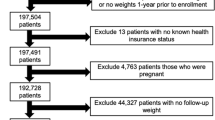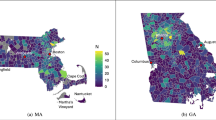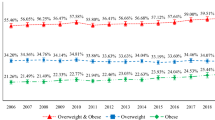Abstract
Individual-level characteristics, including socioeconomic status, have been associated with poor metabolic and cardiovascular health; however, residential area-level characteristics may also independently contribute to health status. In the current study, we used hierarchical clustering to aggregate 444 US Census block groups in Durham, Orange, and Wake Counties, NC, USA into six homogeneous clusters of similar characteristics based on 12 demographic factors. We assigned 2254 cardiac catheterization patients to these clusters based on residence at first catheterization. After controlling for individual age, sex, smoking status, and race, there were elevated odds of patients being obese (odds ratio (OR)=1.92, 95% confidence intervals (CI)=1.39, 2.67), and having diabetes (OR=2.19, 95% CI=1.57, 3.04), congestive heart failure (OR=1.99, 95% CI=1.39, 2.83), and hypertension (OR=2.05, 95% CI=1.38, 3.11) in a cluster that was urban, impoverished, and unemployed, compared with a cluster that was urban with a low percentage of people that were impoverished or unemployed. Our findings demonstrate the feasibility of applying hierarchical clustering to an assessment of area-level characteristics and that living in impoverished, urban residential clusters may have an adverse impact on health.
This is a preview of subscription content, access via your institution
Access options
Subscribe to this journal
Receive 6 print issues and online access
$259.00 per year
only $43.17 per issue
Buy this article
- Purchase on Springer Link
- Instant access to full article PDF
Prices may be subject to local taxes which are calculated during checkout



Similar content being viewed by others
References
Heidenreich PA, Albert NM, Allen LA, Bluemke DA, Butler J, Fonarow GC et al. Forecasting the impact of heart failure in the United States: a policy statement from the American Heart Association. Circ Heart Fail 2013; 6: 606–619.
Havranek EP, Mujahid MS, Barr DA, Blair IV, Cohen MS, Cruz-Flores S et al. Social determinants of risk and outcomes for cardiovascular disease: a scientific statement from the American Heart Association. Circulation 2015; 132: 873–898.
Kaplan GA, Keil JE . Socioeconomic factors and cardiovascular disease: a review of the literature. Circulation 1993; 88: 1973–1998.
Mozaffarian D, Benjamin EJ, Go AS, Arnett DK, Blaha MJ, Cushman M et al. Heart disease and stroke statistics—2015 update: a report from the American Heart Association. Circulation 2015; 131: e29–322.
Ramsay SE, Morris RW, Whincup PH, Subramanian SV, Papacosta AO, Lennon LT et al. The influence of neighbourhood-level socioeconomic deprivation on cardiovascular disease mortality in older age: longitudinal multilevel analyses from a cohort of older British men. J Epidemiol Community Health 2015; 69: 1224–1231.
Major JM, Doubeni CA, Freedman ND, Park Y, Lian M, Hollenbeck AR et al. Neighborhood socioeconomic deprivation and mortality: NIH-AARP diet and health study. PLoS One 2010; 5: e15538.
Brown AF, Liang LJ, Vassar SD, Stein-Merkin S, Longstreth WT, Jr., Ovbiagele B et al. Neighborhood disadvantage and ischemic stroke: the Cardiovascular Health Study (CHS). Stroke 2011; 42: 3363–3368.
Aslanyan S, Weir CJ, Lees KR, Reid JL, McInnes GT . Effect of area-based deprivation on the severity, subtype, and outcome of ischemic stroke. Stroke 2003; 34: 2623–2628.
Diez Roux AV, Merkin SS, Arnett D, Chambless L, Massing M, Nieto FJ et al. Neighborhood of residence and incidence of coronary heart disease. N Engl J Med 2001; 345: 99–106.
Kershaw KN, Diez Roux AV, Bertoni A, Carnethon MR, Everson-Rose SA, Liu K . Associations of chronic individual-level and neighbourhood-level stressors with incident coronary heart disease: the Multi-Ethnic Study of Atherosclerosis. J Epidemiol Community Health 2015; 69: 136–141.
Deguen S, Lalloue B, Bard D, Havard S, Arveiler D, Zmirou-Navier D . A small-area ecologic study of myocardial infarction, neighborhood deprivation, and sex: a Bayesian modeling approach. Epidemiology 2010; 21: 459–466.
Geraghty EM, Balsbaugh T, Nuovo J, Tandon S . Using Geographic Information Systems (GIS) to assess outcome disparities in patients with type 2 diabetes and hyperlipidemia. J Am Board Fam Med 2010; 23: 88–96.
Li X, Memarian E, Sundquist J, Zoller B, Sundquist K . Neighbourhood deprivation, individual-level familial and socio-demographic factors and diagnosed childhood obesity: a nationwide multilevel study from Sweden. Obes Facts 2014; 7: 253–263.
Powell-Wiley TM, Cooper-McCann R, Ayers C, Berrigan D, Lian M, McClurkin M et al. Change in neighborhood socioeconomic status and weight gain: Dallas Heart Study. Am J Prev Med 2015; 49: 72–79.
Yen IH, Michael YL, Perdue L . Neighborhood environment in studies of health of older adults: a systematic review. Am J Prev Med 2009; 37: 455–463.
Richardson S, Shaffer JA, Falzon L, Krupka D, Davidson KW, Edmondson D . Meta-analysis of perceived stress and its association with incident coronary heart disease. Am J Cardiol 2012; 110: 1711–1716.
Brown P, Guy M, Broad J . Individual socio-economic status, community socio-economic status and stroke in New Zealand: a case control study. Soc Sci Med 2005; 61: 1174–1188.
Yan T, Escarce JJ, Liang LJ, Longstreth WT, Jr., Merkin SS, Ovbiagele B et al. Exploring psychosocial pathways between neighbourhood characteristics and stroke in older adults: the cardiovascular health study. Age Ageing 2013; 42: 391–397.
Sundquist K, Malmstrom M, Johansson SE . Neighbourhood deprivation and incidence of coronary heart disease: a multilevel study of 2.6 million women and men in Sweden. J Epidemiol Community Health 2004; 58: 71–77.
Diez Roux AV, Mair C . Neighborhoods and health. Ann N Y Acad Sci 2010; 1186: 125–145.
Hajat A, Diez-Roux AV, Adar SD, Auchincloss AH, Lovasi GS, O'Neill MS et al. Air pollution and individual and neighborhood socioeconomic status: evidence from the Multi-Ethnic Study of Atherosclerosis (MESA). Environ Health Perspect 2013; 121: 1325–1333.
Coogan PF, White LF, Evans SR, Adler TJ, Hathaway KM, Palmer JR et al. Longitudinal assessment of urban form and weight gain in African-American women. Am J Prev Med 2011; 40: 411–418.
Messer LC, Laraia BA, Kaufman JS, Eyster J, Holzman C, Culhane J et al. The development of a standardized neighborhood deprivation index. J Urban Health 2006; 83: 1041–1062.
Kim D, Diez Roux AV, Kiefe CI, Kawachi I, Liu K . Do neighborhood socioeconomic deprivation and low social cohesion predict coronary calcification?: the CARDIA study. Am J Epidemiol 2010; 172: 288–298.
Lalloue B, Monnez JM, Padilla C, Kihal W, Le Meur N, Zmirou-Navier D et al. A statistical procedure to create a neighborhood socioeconomic index for health inequalities analysis. Int J Equity Health 2013; 12: 21.
Kraus WE, Granger CB, Sketch MH, Jr., Donahue MP, Ginsburg GS, Hauser ER et al. A guide for a cardiovascular genomics biorepository: the CATHGEN experience. J Cardiovasc Transl Res 2015; 8: 449–557.
Ward-Caviness CK, Kraus WE, Blach C, Haynes CS, Dowdy E, Miranda ML et al. Association of roadway proximity with fasting plasma glucose and metabolic risk factors for cardiovascular disease in a cross-sectional study of cardiac catheterization patients. Environ Health Perspect 2015; 123: 1007–1014.
Bart BA, Shaw LK, McCants CB, Jr., Fortin DF, Lee KL, Califf RM et al. Clinical determinants of mortality in patients with angiographically diagnosed ischemic or nonischemic cardiomyopathy. J Am Coll Cardiol 1997; 30: 1002–1008.
Auchincloss AH, Van Nostrand JF, Ronsaville D . Access to health care for older persons in the United States: personal, structural, and neighborhood characteristics. J Aging Health 2001; 13: 329–354.
U.S. Census Bureau. U.S. Census Bureau Plans and rules for taking the Census 2000 Available from https://www.census.gov/population/www/censusdata/resid_rules.html#Students.
U.S. Census Bureau Summary Files 1 and 3 [Internet]. 2000 [cited Sep 26, 2015]. Available from http://factfinder.census.gov/faces/nav/jsf/pages/index.xhtml.
Purser JL, Kuchibhatla MN, Miranda ML, Blazer DG, Cohen HJ, Fillenbaum GG . Geographical segregation and IL-6: a marker of chronic inflammation in older adults. Biomark Med 2008; 2: 335–348.
Black JL, Macinko J . The changing distribution and determinants of obesity in the neighborhoods of New York City, 2003-2007. Am J Epidemiol 2010; 171: 765–775.
Ward JH . Hierarchical grouping to optimize an objective function. J Am Stat Assoc 1963; 58: 236–244.
R Core Team R: A Language and Environment for Statistical Computing. Vienna, Austria,: R Foundation for Statistical Computing. 2014.
Austin E, Coull BA, Zanobetti A, Koutrakis P . A framework to spatially cluster air pollution monitoring sites in US based on the PM2.5 composition. Environ Int 2013; 59: 244–254.
Friedman HP, Rubin J . On some invariant criteria for grouping data. J Am Stat Assoc 1967; 62: 1159–1178.
Pedigo A, Seaver W, Odoi A . Identifying unique neighborhood characteristics to guide health planning for stroke and heart attack: fuzzy cluster and discriminant analyses approaches. PLoS One 2011; 6: e22693.
Roussot A, Cottenet J, Gadreau M, Giroud M, Bejot Y, Quantin C . The use of national administrative data to describe the spatial distribution of in-hospital mortality following stroke in France, 2008–2011. Int J Health Geogr 2016; 15: 2.
Pickett KE, Pearl M . Multilevel analyses of neighbourhood socioeconomic context and health outcomes: a critical review. J Epidemiol Community Health 2001; 55: 111–122.
Leigh JP, Du J . Hypertension and occupation among seniors. J Occup Environ Med 2009; 51: 661–671.
Davila EP, Kuklina EV, Valderrama AL, Yoon PW, Rolle I, Nsubuga P . Prevalence, management, and control of hypertension among US workers: does occupation matter? J Occup Environ Med 2012; 54: 1150–1156.
Rollings KA, Wells NM, Evans GW . Measuring physical neighborhood quality related to health. Behav Sci (Basel) 2015; 5: 190–202.
Schaefer-McDaniel N, Caughy MO, O'Campo P, Gearey W . Examining methodological details of neighbourhood observations and the relationship to health: a literature review. Soc Sci Med 2010; 70: 277–292.
Kroeger GL, Messer L, Edwards SE, Miranda ML . A novel tool for assessing and summarizing the built environment. Int J Health Geogr 2012; 11: 46.
Mujahid MS, Diez Roux AV, Morenoff JD, Raghunathan T . Assessing the measurement properties of neighborhood scales: from psychometrics to ecometrics. Am J Epidemiol 2007; 165: 858–867.
Ogilvie RP, Everson-Rose SA, Longstreth WT, Jr., Rodriguez CJ, Diez-Roux AV, Lutsey PL . Psychosocial factors and risk of incident heart failure: the multi-ethnic study of atherosclerosis. Circ Heart Fail 2016; 9: e002243.
Christine PJ, Auchincloss AH, Bertoni AG, Carnethon MR, Sanchez BN, Moore K et al. Longitudinal associations between neighborhood physical and social environments and incident type 2 diabetes mellitus: the Multi-Ethnic Study of Atherosclerosis (MESA). JAMA Intern Med 2015; 175: 1311–1320.
Miranda ML, Edwards SE, Anthopolos R, Dolinsky DH, Kemper AR . The built environment and childhood obesity in Durham, North Carolina. Clin Pediatr (Phila) 2012; 51: 750–758.
Sundquist K, Theobald H, Yang M, Li X, Johansson SE, Sundquist J . Neighborhood violent crime and unemployment increase the risk of coronary heart disease: a multilevel study in an urban setting. Soc Sci Med 2006; 62: 2061–2071.
Carroll-Scott A, Gilstad-Hayden K, Rosenthal L, Peters SM, McCaslin C, Joyce R et al. Disentangling neighborhood contextual associations with child body mass index, diet, and physical activity: the role of built, socioeconomic, and social environments. Soc Sci Med 2013; 95: 106–114.
Chaix B, Rosvall M, Merlo J . Recent increase of neighborhood socioeconomic effects on ischemic heart disease mortality: a multilevel survival analysis of two large Swedish cohorts. Am J Epidemiol 2007; 165: 22–26.
Clark AM, DesMeules M, Luo W, Duncan AS, Wielgosz A . Socioeconomic status and cardiovascular disease: risks and implications for care. Nat Rev Cardiol 2009; 6: 712–722.
Villanueva C, Aggarwal B . The association between neighborhood socioeconomic status and clinical outcomes among patients 1 year after hospitalization for cardiovascular disease. J Community Health 2013; 38: 690–697.
Acknowledgements
We would like to acknowledge Drs Marie Lynn Miranda and Cavin K Ward-Caviness for their involvement in the geocoding of the CATHGEN patients. We thank all of the participants in the CATHGEN study, and we acknowledge the essential contributions of the faculty and staff of the Duke Cardiac Catheterization Lab, the Duke Databank for Cardiovascular Disease, and the Duke Center for Human Genetics for their contributions to this manuscript. This work was supported by United States Environmental Protection Agency internal funds; the EPA Cooperative Agreement with the Center for Environmental Medicine, Asthma, and Lung Biology at the University of North Carolina (CR83346301); the National Institutes of Environmental Health Sciences (T32ES007126); a UNC Golberg Fellowship; the National Institutes of Health (HL73042, HL36587, HL095987); an award from the Neurosciences Education and Research Foundation (Encinitas, CA); and the Health Effects Institute (4946-RFPA10-3/14-7).
Author information
Authors and Affiliations
Corresponding author
Ethics declarations
Competing interests
The authors declare no conflict of interest.
Additional information
Disclaimer
Research described in this article was conducted under contract to the Health Effects Institute (HEI), and organization jointly funded by the United States Environmental Protection Agency (EPA) (Assistance Award No. R-82811201) and certain motor vehicle and engine manufacturers. The contents of this article do not necessarily reflect the views of HEI, or its sponsors, nor do they necessarily reflect the view and policies of the EPA or motor vehicle and engine manufacturers. Mention of trade names or commercial products does not constitute endorsement or recommendation for use.
Supplementary Information accompanies the paper on the Journal of Exposure Science and Environmental Epidemiology website
Supplementary information
Rights and permissions
About this article
Cite this article
Mirowsky, J., Devlin, R., Diaz-Sanchez, D. et al. A novel approach for measuring residential socioeconomic factors associated with cardiovascular and metabolic health. J Expo Sci Environ Epidemiol 27, 281–289 (2017). https://doi.org/10.1038/jes.2016.53
Received:
Accepted:
Published:
Issue Date:
DOI: https://doi.org/10.1038/jes.2016.53
Keywords
This article is cited by
-
The association of accelerated epigenetic age with all-cause mortality in cardiac catheterization patients as mediated by vascular and cardiometabolic outcomes
Clinical Epigenetics (2022)
-
Assessing the quantity and toxicity of chemical releases from TRI facilities in Upstate New York
Journal of Environmental Studies and Sciences (2022)
-
Assessing residential socioeconomic factors associated with pollutant releases using EPA’s Toxic Release Inventory
Journal of Environmental Studies and Sciences (2021)
-
Neighborhood Environments and Diabetes Risk and Control
Current Diabetes Reports (2018)



